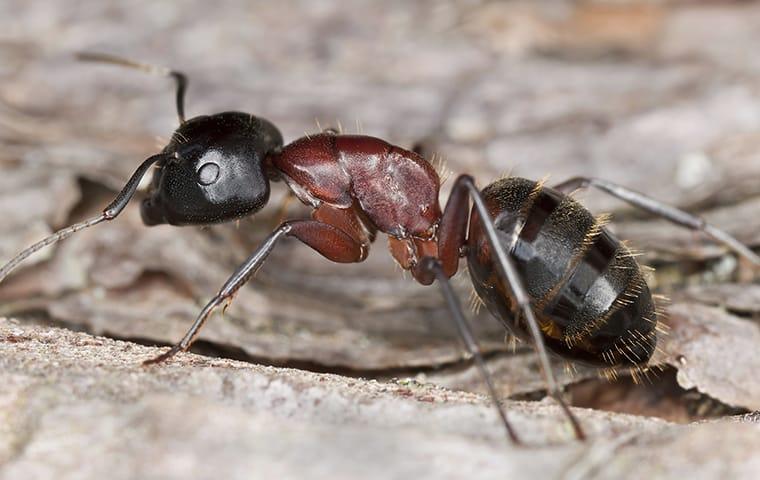

In the majority of cases, the use of insecticidal baits is the preferred method for controlling carpenter ants. Baits should be placed, preferably in the evening or at night, where ants can find and eat it (e.g., next to or on trees where they are nesting or directly on their path). Provide carpenter ants gel bait when attempting to control them outside the home. Close examination of the debris may also reveal parts of dead carpenter ants and the uneaten, discarded pieces and parts of dead insects brought into the nest for food. Because carpenter ants must excavate wood to expand their galleries, it is common to find piles of wood shavings on the ground at the base of a tree where carpenter ants nest. If a nest is present, ants will be seen moving up and down the trunk as they leave from and return to the nest with food.Īn indication of a nest in a tree is the presence of sawdust-like wood shavings on the ground at the base of the tree. To locate outdoor nest sites after dark, inspect nearby large trees by walking around them while shining a flashlight up and down the trunk. To find nest sites indoors, find and follow a few foraging ants to learn where they might be nesting.Ĭarpenter ants in the home oftentimes can be found nesting outdoors. If possible, inspect at night beginning 30 minutes after sunset.


To find the nest, inspect all potential indoor and outdoor nest sites. The key to eliminating carpenter ant infestations is to find the nest and remove it, either physically or by treating it with an insecticide. Finding Nests is the Key to Eliminating Carpenter Ants It is not only found nesting in trees but also under loose debris found lying on the ground (e.g., old doors, roof shingles, cardboard boxes, plywood, in soft drink cans, etc.) as well as in stumps, logs, railroad ties, etc.

The Florida carpenter ant is more opportunistic in its nesting habits. Colonies are less commonly found in stumps, logs, railroad ties, etc. There they chew dead wood to create and expand galleries for nest sites. Most large hardwood trees contain a knothole, treehole or other natural void where ants find a habitat that is ecologically stable (consistent humidity and temperature) and protected from adverse environmental conditions and natural enemies (Figure 4). Outdoors, nests are most commonly found in hardwood trees. Outdoors, a common nest site of carpenter ants is in hardwood trees containing a knothole or treehole where ants find an environment that is ecologically stable and protected from adverse environmental conditions. Some examples of where ants have been found nesting inside are in moisture-damaged wood around chimneys and skylights, under bathtubs, inside dishwasher walls, in wall voids beneath window sills, inside hollow doors and door frames, under fiberglass insulation in crawlspaces and in wall voids, in wooden porch supports and columns, under siding and wood shingles, and in moisture-damaged eaves.įigure 4. In the evening, ants can be seen using these paths as they emerge from and return to their nest.Ĭarpenter ants may establish nest sites inside and/or outside the home. Ants emerge about 15 minutes after sundown and leave the nest in large numbers, traveling up to hundreds of feet between nest sites and feeding sites on semi-permanent paths that the ants construct and maintain (Figure 3). In Georgia, carpenter ants are active from late spring (May/June) through early fall (September/October). Carpenter ants construct and use semi-permanent paths as they move between nest sites and feeding sites, and will even use the same path from one year to the next. Should you have questions regarding a carpenter ant problem contact your county extension agent by calling 1-800-ASK-UGA1 or visit the University of Georgia Extension website at. Because ants from a single carpenter ant colony vary greatly in size, ant size alone is usually not a good characteristic for identification. Florida carpenter ants are most common in southern and southeastern Georgia, while the black carpenter ant is more common inland in central and northern Georgia. Black carpenter ants are dull black in color and their abdomens are covered with yellowish hairs (Figure 1), while the Florida carpenter ant has a deep reddish-colored head and thorax and a shiny black abdomen (Figure 2). In Georgia, there are two important pest species: the black carpenter ant ( Camponotus pennsylvanicus) and the Florida carpenter ant ( Camponotus floridanus). They are most common in southern and southeastern Georgia. Florida carpenter ants (~3/8 up to ~5/8 inch) have a reddish-colored head and thorax and a shiny black abdomen.


 0 kommentar(er)
0 kommentar(er)
